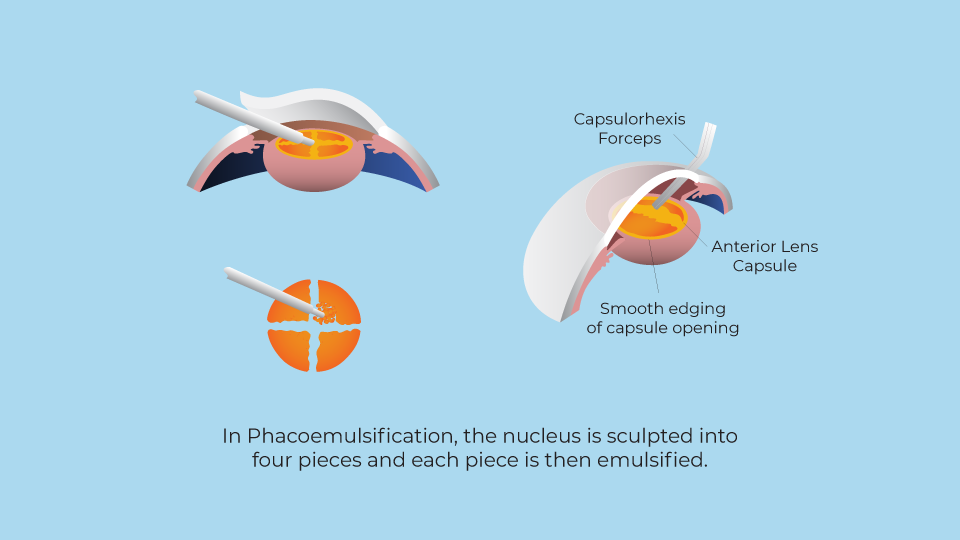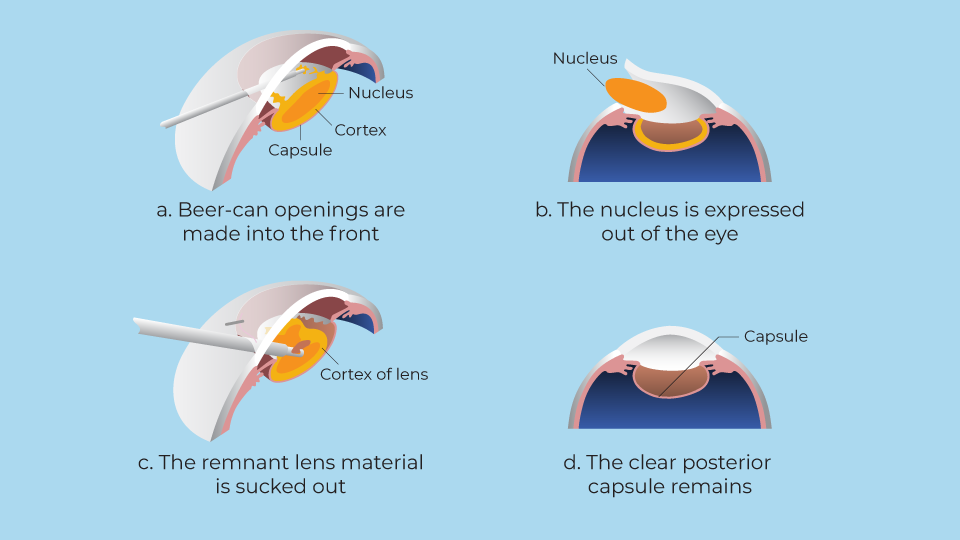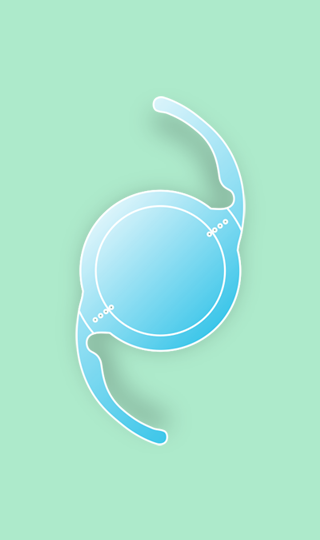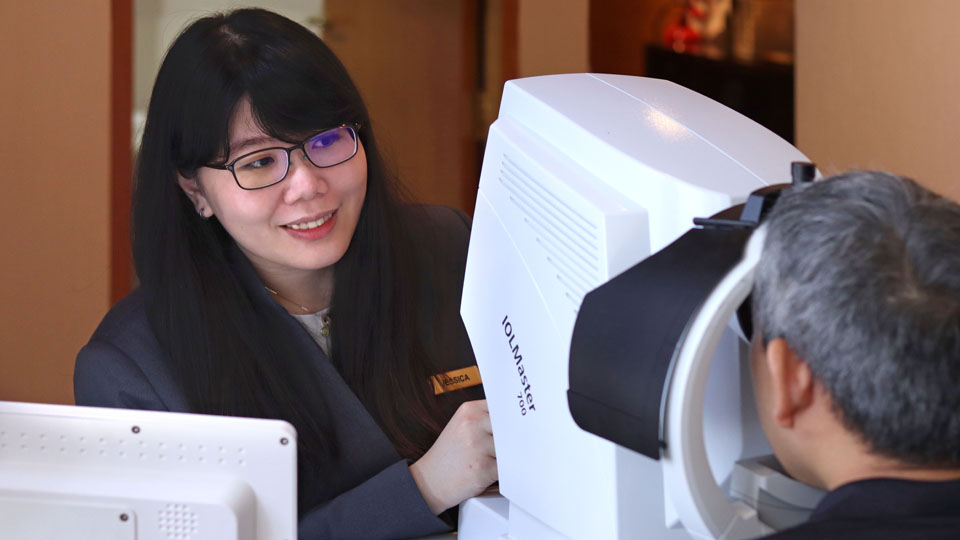Cataract Surgery
Cataracts Video
What are Cataracts?
A cataract is the clouding of the eye's natural lens. The lens works similar to a camera lens: it focuses light onto the retina at the back of the eye. The lens also adjusts the eye's focus, letting us see things clearly both at near and distance. However, if the lens gets clouded, the image we see will be blurred. The most common reason for developing cataracts is ageing.
What are the Symptoms of Cataracts?
- Cloudy or blurry vision
- Colours seem faded
- Glare - headlights, lamps or sunlight may appear too bright
- A halo around lights
- Poor vision at night or dim surroundings
- Double vision or multiple images are seen by one eye
How is Cataract Surgery Done?
There are 2 available surgeries:
-
Phacoemulsification (no-stitch small incision cataract surgery)
- Incision size: 2.2- 2.7mm
- A soft, foldable lens implant
- Single stitch or no stitch required
Cataract extraction with phacoemulsification and implantation of a foldable lens is considered the "gold standard" technique and is widely used. It is good for almost all cataracts.
How is it performed?
- The cataract is removed using ultrasonic energy through a microscopic opening.
- An artificial intraocular lens implant (IOL) is then placed into the eye.
- Under certain circumstances, your surgeon may recommend laser-assisted phacoemulsification surgery. The principles are essential the same but a laser is used at certain stages of the surgery instead of conventional instruments.

Suturing is usually not required and restoration of vision is much faster than conventional cataract surgery.
-
Extracapsular cataract surgery
- Incision size: 10 to 12mm
- Hard, plastic implant
- Multiple stitches required (~7 to 8 stitches)
How is it performed?

This is very established, older method cataract surgery now used for thicker, harder cataracts or other situations where phacoemulsification is less suitable)
What are the types of intraocular lens implants (IOL)?
An intraocular lens implant (IOL) is placed within the capsule of the removed cataractous lens. The IOL can be made of a stiff material like silicone or acrylic.
 |
 |
 |
| Monofocal Aspheric IOL |
Monofocal Aspheric Toric IOL |
Multifocal IOL |
There are 3 main types of IOLs:
-
Monofocal aspheric lenses
- Give the best quality day and night vision
- Patients still have to wear reading glasses
- Do not correct pre-existing astigmatism
-
Monofocal aspheric toric lenses
- Reduce or eliminate astigmatism
- Give good quality night vision
- Good for patients with high pre-existing astigmatism of 100 degrees and above
- Patients still have to wear reading glasses
-
Multifocal and Extended Depth of Focus (EDOF) lenses
- Good for people who are highly motivated not to wear reading or distance glasses
- Some compromise on quality of vision in dim/ night conditions with higher chance of haloes and glare at night, as a side effect
- Lenses can come with correction for astigmatism
More recent lens designs reduced the problems of glare and haloes somewhat but the problem of reduced contrast still exists.
Besides multifocal intraocular lens implants, another popular solution to help older presbyopic patients reduce their dependence on spectacles for distance and near vision is Monovision.
Laser-Assisted Cataract Surgery with a Multifocal Lens Video
Laser-Assisted Cataract Surgery with a Multifocal Toric Lens Video
Diagnosing and Treating Cataract
How are cataracts diagnosed?
Cataracts can be diagnosed only a thorough eye examination which includes the following tests:
-
Visual acuity test
This eye chart test measures how well you see at various distances.
-
Dilated eye examination
Eyedrops are instilled in your eye to enlarge (dilate) your pupils. The Optos retinal scan will be used to examine your retina and optic nerve for signs of damage and other eye problems. After the examination, your near vision may remain blurry and you will be sensitive to light for a few hours.
-
Tonometry
Your eye pressure will be measured to exclude an eye disease called glaucoma. Numbing drops will be instilled in your eye for this test.
-
Anterior segment analysis - Scheimpflug and retro illumination photography of the lens
This special diagnostic machine was first used as a research tool to measure the optical density of the human lens and cataracts. Cataracts can then be objected graded, which permits trending of cataract progression.
Other tests, like Macula Optical Coherence Tomography (OCT), may also be performed to get more information on the structure and health of your eyes.
How are cataracts treated?
- If your vision is still good and has not affected your activities of daily living (ADLs), you can temporarily aid your vision by:
- Updating your glasses to your latest degree.
- Magnifying or increasing the font size of your reading material
- Using good lighting
- If your vision is impaired and affects your ADLs, preventing you from doing the things you like to do, you can choose to undergo cataract surgery.
Cataract Surgery Expectations
Before surgery
Before the surgery, we will perform some essential tests to choose the right prescription (power) and type of IOL for you. The tests include:
- Measuring the shape of the eye (topography)
- Length of the eye (biometry) – a specialized test to measure the power of the IOL to be placed in your eye. It can be done with contact ultrasound, immersion ultrasound and laser-interferometry (shown below).
Our doctors may advise you to consider monovision as an option for your vision correction.

Eyedrops need to be applied one day before your operation and you will need to fast for 6 hours before your surgery.
It is important to note that the tests' results are only valid for 3 months.
During surgery
- Surgery will be done at Novaptus Surgery Centre, other equivalent centre.
- Upon admission at the Day Surgery ward, your pupil will be enlarge using dilating eye drops.
- Surgery usually lasts about 20-30 minutes.
- You will be sedated by an anaesthesiologist and will not feel pain during the surgery.
- The area around your eye will be washed and cleansed. Topical and/or local anaesthetic will be given to numb the nerves of your eye.
- After the operation, an eye pad will be placed over your eye. You will rest for about 1-3 hours.
Our medical team will watch for any problems such as an increase in eye pressure or bleeding. Most patients who have cataract surgery can go home the same day. You will need someone to drive you home.
After surgery
| 1 day post-op |
|
|---|---|
| 1 week post-op |
|
| 4 to 5 weeks post-op |
|
| Within 6 weeks |
|
The above estimated visual recovery is applicable for patients who underwent phacoemulsification surgery.
Possible Cataract Complications
Are there any complications after cataract surgery?
Problems after surgery are rare but can occur. These problems may include:
- Infection
- Bleeding
- Inflammation (pain, redness, swelling)
- Loss of vision
- Double vision
- High or low eye pressure
With prompt medical attention, these problems can usually be treated successfully.
"After-cataract" or posterior capsule opacification
Sometimes, the capsule that encloses the IOL becomes cloudy and may blur your vision. This condition is called an "after-cataract". An "after-cataract" can develop months or years after cataract surgery.
How is an "after-cataract" treated?
An outpatient procedure called YAG laser capsulotomy is done to treat an “after-cataract”. Our doctor will use a YAG laser to make a tiny hole in the capsule behind the lens to let light pass through unimpeded. It is painless, rarely results in increased eye pressure or other eye problems and has virtually no extra downtime except the day of the surgery. As a precaution, our doctors will give you eye drops to prophylactically reduce inflammation after the procedure.
YAG Capsulotomy Video